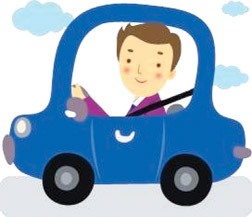Safe driving in today's environment
The key to safe driving, lies in the adoption of a responsible
attitude to the task of driving coupled with the development of correct
technique in handling ones vehicle with a sound understanding of the
hazards prevalent on roads.
Traffic volumes, road environment and traffic conditions do not
remain stationery, they change continuously and rapidly.
These features change year after year causing more and more
challenges to those at the wheel.
 This requires the need to constantly review and where necessary to
adapt ones driving to meet such challenges by improving ones skills and
technique to keep pace with the change and challenges, otherwise your
driving will become outdated, inappropriate and perhaps dangerous. This requires the need to constantly review and where necessary to
adapt ones driving to meet such challenges by improving ones skills and
technique to keep pace with the change and challenges, otherwise your
driving will become outdated, inappropriate and perhaps dangerous.
To most, the driving license is the ultimate objective, and neither
one's knowledge, technique and skill is allowed to mature beyond that.
But the challenges in driving requires one to keep on perfecting each
day ones technique both in driving and safety attitudes.
No matter how good a driver may be or how experienced he may be, in a
split second a human error could occur while driving.
It is imperative for drivers to take cognizance of this fact and make
every endeavour to drive correctly and safely at all times.
He should do so, not because of his legal obligations but because of
his moral commitment to society-a commitment which makes him to take
every conceivable precaution to steer clear of accident situations or
being involved in a human tragedy.
Road accidents are generally caused by the driver's response or lack
of response to an unpredictable situation in the road environment.
Whatever the development or progress that has been made in road
engineering or automotive technology to achieve greater safety, drivers
and their general standard of driving will continue to influence safety
on the highway for as long as human beings are needed to manoeuvre a
motor vehicle.
Speed and safety
The speed at which one decides to drive is one of the foremost
factors in determining the likely risk of meeting with an accident.
The more you step on the accelerator, the less chance you have of
evasive action and greater the chance of having an accident in an
unforeseen situation. Speed is largely a matter of choice-the occasion's
when it is absolutely safe to drive fast is limited.
Good driving requires speed to be related to safe road conditions
around you, your capability, your physical/mental alertness, the
condition of one's vehicle and prevailing weather.
Very often drivers tend to suffer from the lack of illusion of
vehicle control, which is a tendency to overestimate their actual
capability to the demands of road and traffic conditions. There is a
general perception to undermine risks when at the wheel for example
young drivers tend to drive faster to impress others. At the same time
more experienced drivers tend to build a false sense of their competence
as safe drivers. You will be a safe driver only if you develop
appropriate driving attitudes by driving according to circumstances
justify. The speed at which one drives is one of the foremost factors in
determining your risk of having an accident. The faster you drive the
less chance you have of preventing an accident and greater the risk of
an accident. Most drivers give little thought to reaction time and
minimum stopping distances required to stop in an emergency.
The reaction time is the moment you observe a danger and your
commencement of the application of vehicle controls. The average drivers
reaction time is approximately three fourth of a second provided he or
she is mentally alert and physically in sound condition, if not your
reaction time could be more by a further fraction of a second which
means you take more time to engage vehicle controls to avert danger.
Driving after consuming alcohol also slows down reaction time of
drivers. Certain accidents we see without break/skid marks could come
within this category since the crash has occurred before the application
of brakes. At 70 mph the shortest distance that you can stop is 96
meters (315 ft) which includes total distance travelled covering
thinking distance and breaking distance.
A vehicle travelling at 30 mph requires a stopping distance of 23
meters. Travelling at 50 mph a distance of 53 meters and travelling at
70 mph 96 meters. To work out overall stopping distance add thinking
distance to breaking distance. Thinking distance varies according to
speed of vehicle and the physical and mental alertness of a driver. The
braking distance varies on the vehicle braking efficiency, gradient of
the road and the condition of the road surface.
Camillus
R Abeygoonewardena
The writer is the former DIG Traffic Administration and Road Safety
|





